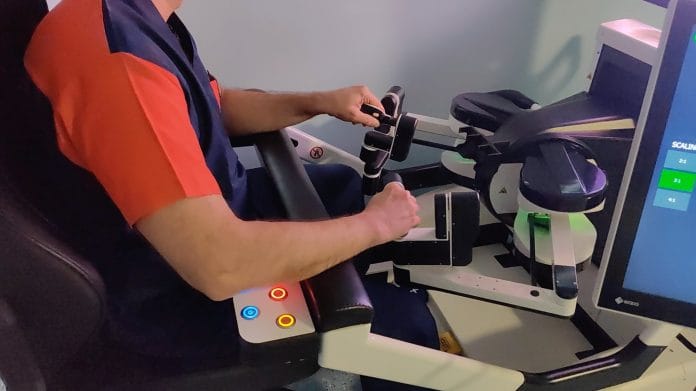New Delhi: SSI Mantra, a surgical robotic system, became the first in the country to be granted approval by the Central Drugs Standard Control Organisation (CDSCO) this month to carry out telesurgery, or remotely perform surgeries in patients using a robot and wireless technology.
The system—developed by SS Innovations (SSI), an Indian company making indigenous surgical robots—was used in carrying out six telesurgeries this year as part of clinical trials.
During these trials, while surgeons were at the SSI office in Gurugram, the patients undergoing the robotic-assisted surgeries (RAS) were in operation theatres at hospitals several kilometres away from the centre.
RAS uses a robotic device under the guidance of a trained surgeon and employs a video game-like console, where the surgeon sits with special eyeglasses to look at a monitor displaying magnified 3D layouts, and regulates the surgical procedure by moving his arms and fingers.
Robotic arms at the operating table make small incisions in the required spots in the patient’s body and thin tube-like tools, called ports, are placed at the cuts for inserting the surgical equipment.
Telesurgery uses wireless networking and robotic technology to allow surgeons to operate on patients, who are distantly located. Assistant surgeons and others in the team, however, can be near the operation table to monitor the procedure and change any equipment, if needed.
Also Read: Indigenous, affordable, how robot-assisted surgeries are finding takers in smaller Indian cities
‘Big leap’
Apart from robotic surgical systems, performing RAS needs strong wireless networking. Telesurgery has been pitched to help address healthcare challenges, such as the shortage of surgeons and the lack of access to high-quality surgical care in remote areas.
The world’s first telesurgery was conducted in 2001 by a surgical team in New York in the US, using the ZEUS robotic system by US-based robotic surgical device maker, Intuitive Surgical. This involved a two-hour-long cholecystectomy or removal of the gallbladder, performed on a female patient at a hospital in Strasbourg, France.
Back home, as part of the telesurgery trial, the same procedure was carried out for a patient at Gurugram’s World Laparoscopy Hospital in June this year, with surgeon Dr R.K. Mishra performing RAS from the SSI headquarters in the city, five kilometres away from the hospital.
Following this, five more telesurgeries that included procedures like radical nephrectomy, which involves removal of the kidney and surrounding tissues, and hysterectomy, or removal of uterus, among others, were performed using SSI Mantra.
SSI, meanwhile, said that the latest CDSCO approval has the potential to transform surgical practices, enhance access and drive the adoption of robotic surgery in the country.
“With the technology and bandwidth available now, we can truly decentralise and democratise surgical expertise, bringing world-class care to patients and surgeons in even the most remote parts of India and beyond,” Dr Sudhir Srivastava, SSI’s founder, chairman and chief executive, told ThePrint.
ThePrint had previously reported how the acceptance and demand for RAS is growing across India—even in non-metro cities—and that every year, nearly 60,000 such operations are being carried out in the country.
Opportunities & limitations
Telesurgeries, experts said, open up new possibilities for providing expert surgical care to patients in remote or underserved areas, reducing the need for travel and associated costs.
This breakthrough also paves the way for more collaborative efforts in the medical community, enabling surgeons to share expertise and perform complex procedures across geographical boundaries.
“Telesurgery transcends geographical limitations, enabling a surgeon based in Delhi to perform operations in any part of the country without the need for physical travel,” Dr Sudhir Rawal, medical director & chief of uro-genito oncology at Delhi’s Rajiv Gandhi Cancer Institute and Research Centre (RGCIRC), told ThePrint.
Rawal carried out five of the six telesurgeries in SSI’s clinical trials.
This groundbreaking technology, he said, allows medical expertise to be delivered remotely, overcoming distance and facilitating access to high-quality care in even the most distant regions.
But some other experts also underlined that ensuring the reliability and security of the telecommunication infrastructure for carrying out the procedure is very crucial.
“Any lag or interruption in communication could be concerning from a patient’s safety point of view. Also, the cost of advanced robotic systems and the necessary communication technology can be prohibitive, especially for government healthcare institutions in a country like India,” said a cardiac surgeon at the All India Institute of Medical Sciences (AIIMS), Delhi, who did not wish to be named.






